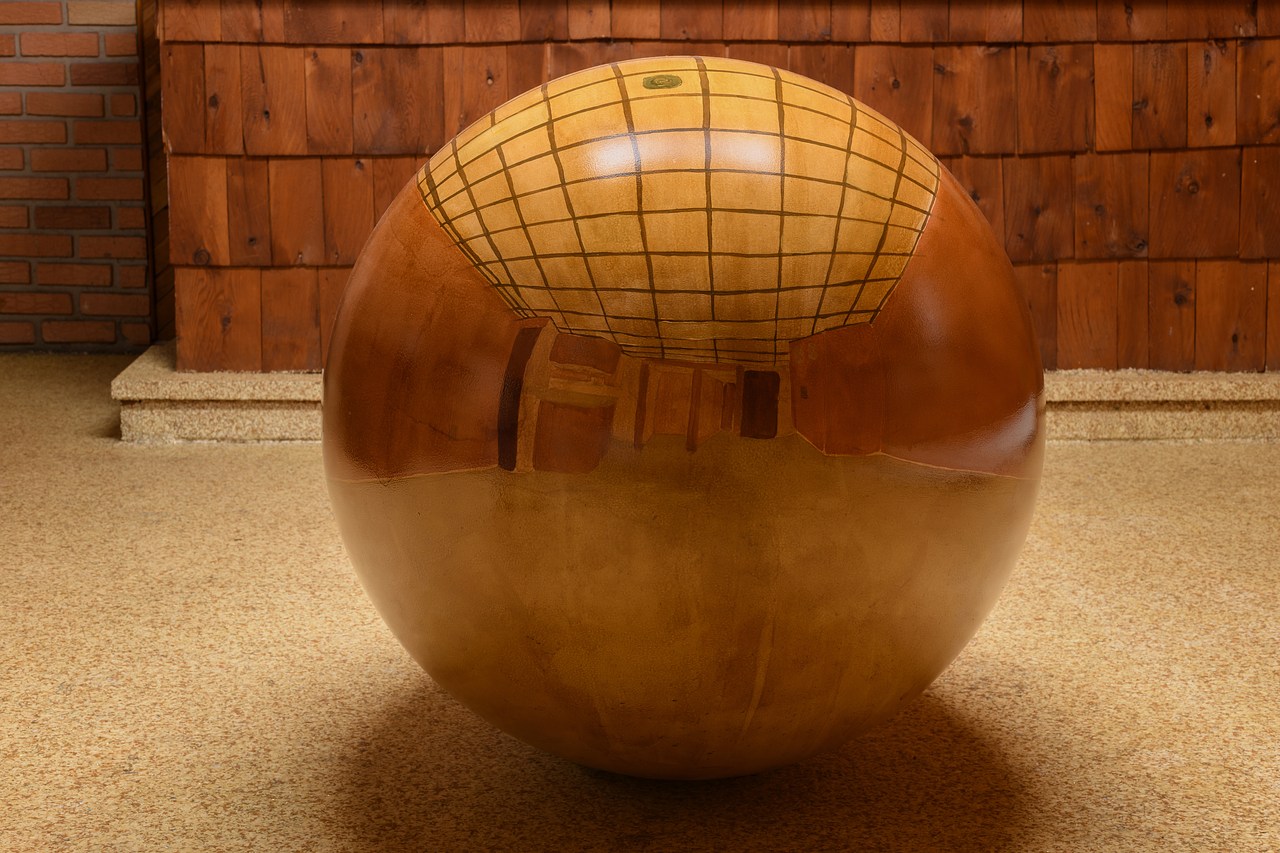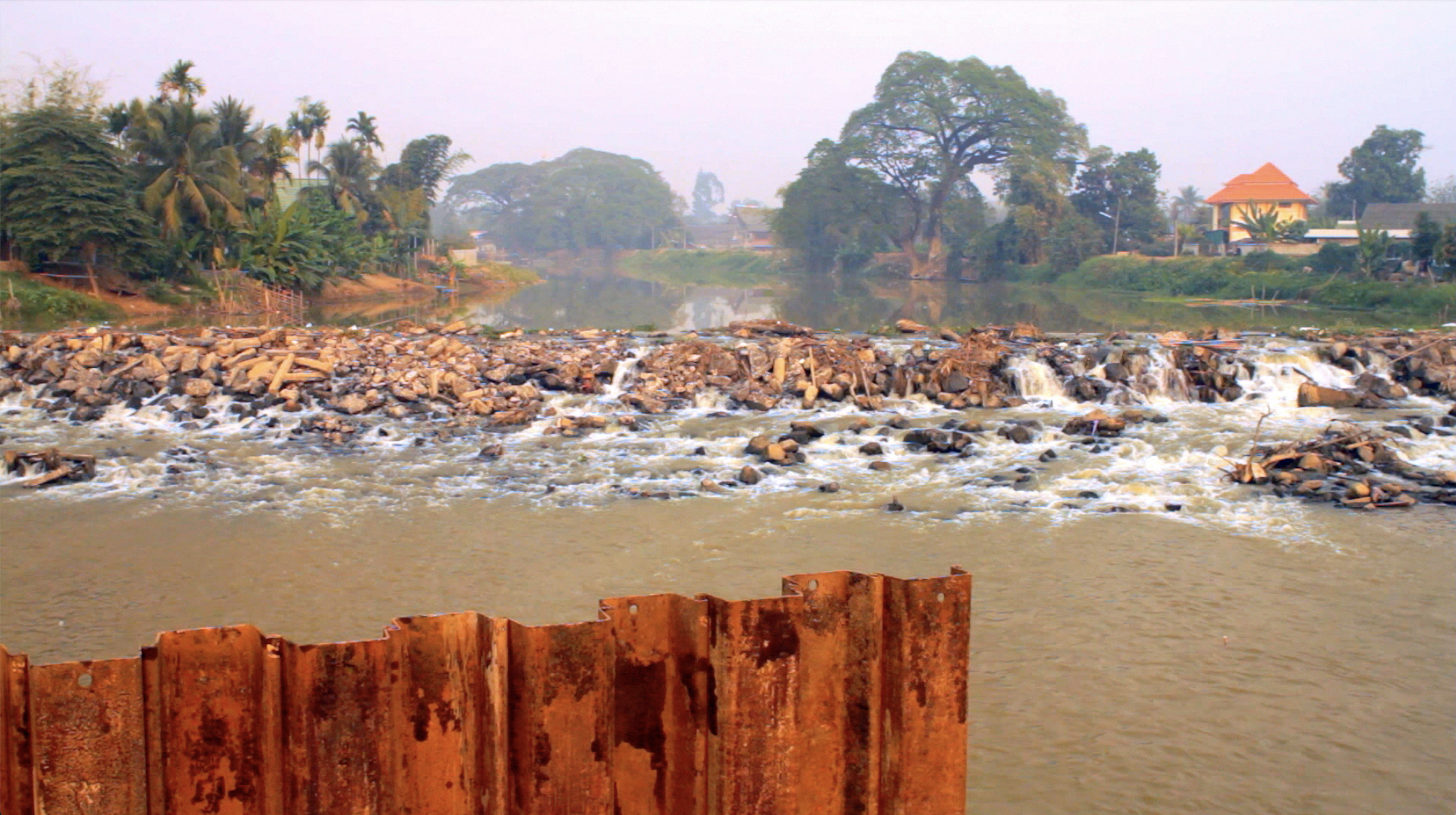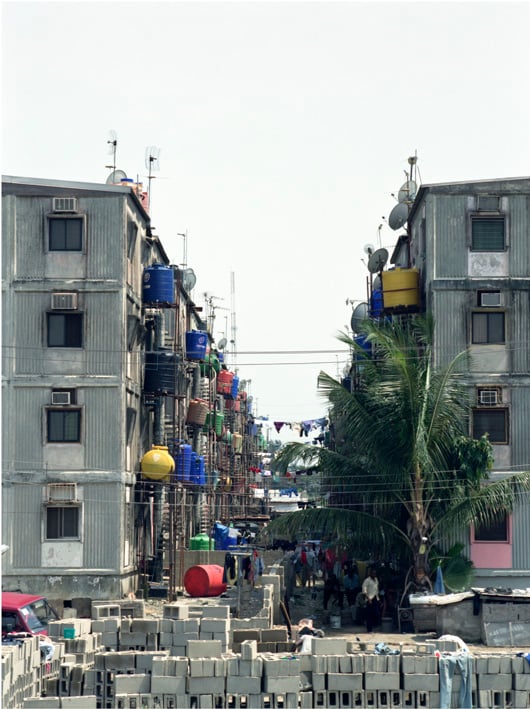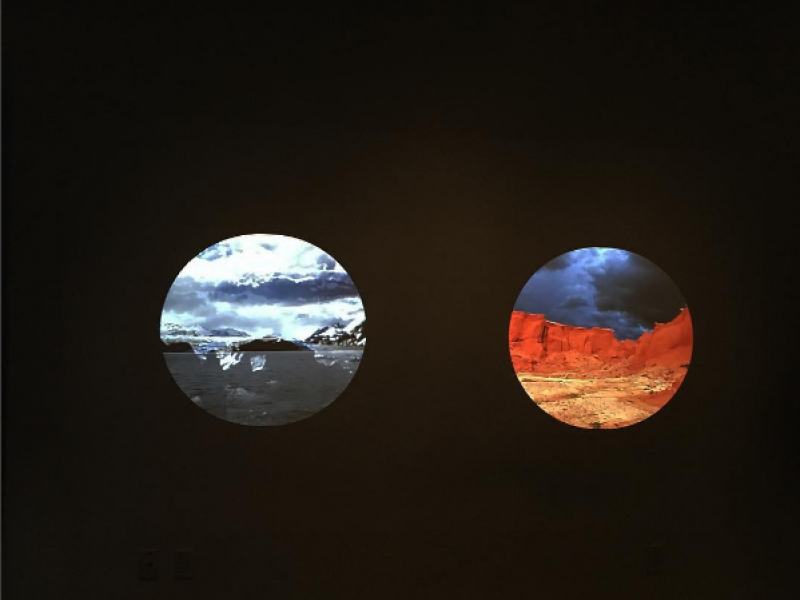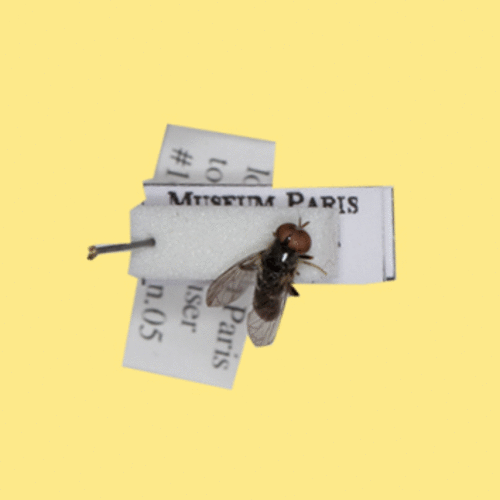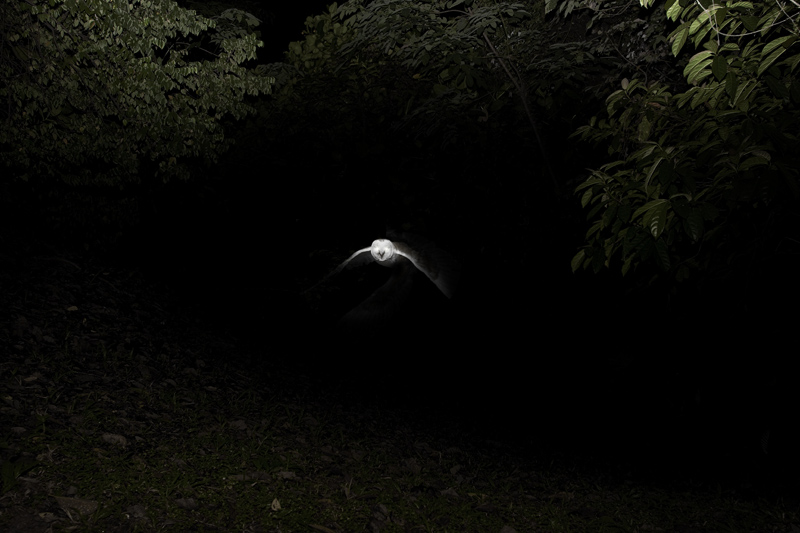
© » KADIST
Carlos Fernández
Part of the exhibition PIÑA MATRIZ (2014) at Despacio Art, this untitled work by Carlos Fernández is a wood panel (formerly a section of a wooden table top) that bears the residue of insects interacting with fermented pineapple. The exhibition considered the production of pineapple monocultures and the agricultural monopolies for this product. Fernández used the exhibition space to portray alternative possibilities of diversified and ecologically sustainable production that could be mobilized in place of mass produced pineapple monocultures.

© » KADIST
Miguel and Natalia Fernández de Castro and Mendoza
The Absolute Restoration of All Things is a collaboration by artist Miguel Fernández de Castro and anthropologist Natalia Mendoza. For this project, Fernández de Castro and Mendoza researched the 2014 court case that shut down Penmont Mining’s operations in the middle of the Sonoran desert. The lawsuit was brought to court by the “ejidatarios” (communal land holders) of El Bajío, Sonora, who claimed that their territory was illegally occupied and exploited, causing an irrevocable environmental impact on their land.

© » KADIST
Connie Zheng
The Lonely Age by Connie Zheng is the first chapter in a trilogy of short experimental films about the complex temporalities of navigating ongoing environmental crises, as seen through the lens of seeds real and imagined. The film is set in a highly toxic and ecologically ravaged near future, in which people begin to hear rumors of seeds that have washed up on the shores of California after escaping from a factory in China. The seeds are rumored to possess curative properties, but they are also said to be sentient.

© » KADIST
Noémie Goudal
Noémie Goudal’s short film, Below the Deep South , is based on the work of palaeoclimatologist James Bendle who, while drilling in Antarctica, discovered coal beneath the ice. Bendle’s theory is that the coal is an indication that Antarctica was once a lush, green forested environment with insects and animals. It only arrived in its present position due to the shifting of tectonic plates.

© » KADIST
Som Supaparinya
When Need Moves the Earth is a three-channel video that combines elements of documentary footage, archival material and abstract aerial shots to encompass a painterly yet forthright exploration of a coal mine and a water dam in Thailand. A meditation on the impact of industrialization on the natural environment, the work highlights the drastic alterations that these operations leave in its place. Som Supaparinya’s work is often a commentary on political, social, and personal issues.

© » KADIST
Mohamed Bourouissa
Drawing & Print (Drawing & Print)
In his photographic series Périphérique (2005–2008), Mohamed Bourouissa used the composition of classical paintings to stage the portrait of friends and young people in the banlieue s (suburbs). He states “by deconstructing the clichés surrounding this subject, I deal with the problematic power struggle and its mechanics.” This series follows various themes explored throughout the work of Bourouissa. For Temps Morts, his first film, he depicted a yearlong series of mobile phone exchanges with someone in prison.

© » KADIST
Ana Roldán
Ana Roldán’s Primeval forms series looks up close at the fecund shapes of plants often found in the artist’s native Mexico. These botanical portraits, like this one of the Pseudobombax ellipticum, or shaving brush tree, bristle against the edges of the image’s frame, fecund and wild, familiar yet foreign. Ana Roldán works in diverse media such as performance, sculpture, installations, video and collage.

© » KADIST
John Gerrard
Flag (Thames) 2016 depicts a small section of the Thames River—one that is adjacent to the Palace of Westminster in London—as an algorithmic representation on an LED panel. The river color is vividly represented with reflections of buildings along the riverbank, including Big Ben. At the center of the scene sits a simulated gasoline spill.

© » KADIST
Benvenuto Chavajay Gonzalez
Jardín (2013) refers to environmental destruction, specifically the preponderance of disposable plastics, as well as Medellín’s long history of dangerous conflict; it was once considered the most violent city in the world because of the drug trafficking there. This floor sculpture consists of shoes made of river stones, strung with flip-flop straps. Here, Chavajay plays the natural (found stones) against the synthetic (plastic), heavy against light, hard against soft, revealing the irony of their fusion and the impossibility of their alleged function as shoes.

© » KADIST
Robert Zhao Renhui
Changi, Singapore, possibly 1970s is from the series “As We Walked on Water” (2010-2012), which looks into Singapore’s history around the phenomenon of land reclamation. After exhausting the country’s own soil from its tiny hills and ridges, the government had to buy sand from Malaysia and Indonesia to continue its reclamation efforts. At the early stages of a land reclamation project, the imported sand would sit idle for some time, forming an artificial desert-like landscape.

© » KADIST
Brook Andrew
This year: missing witness by Brook Andrew consists of a multi-layered collage of photographs. The work features newspaper cut-outs of the phrases: “This year: be prepared…” and “missing witness” overlaid onto a disaster scene, upon a worn-up manuscript. Pulled from The New York Times , the image is of a destroyed temple on the Indonesian island of Sulawesi, that has increasingly experienced natural disasters due to climate change.

© » KADIST
Zhou Tao
For over five months, Zhou situated himself in an underdeveloped village surrounded by the high skyscrapers of Guangzhou to produce South Stone . Interweaving footage of a village’s landscape, residents, and animals with his seemingly absurd interventions with the place, South Stone indicates the equally incoherent social reality. Fluctuating between documentary and fiction, the film catalyzes alternative connections in time, and the emergence of imaginative spaces.

© » KADIST
Enar de Dios Rodríguez
Ecotone by Enar de Dios Rodríguez is a video work presented in six chapters, each beginning and ending with a one-sided telephone dialog with an informal, friendly and conversational tone, that leads quickly into complex philosophical subjects. The first chapter is an introduction, and the last is an epilogue, and both employ interfaces (a smartphone screen, and an optical illusion, respectively) to invite the viewer to make conceptual connections across the chapters. An “ecotone” is a region of transition between two biological communities.

© » KADIST
Robert Zhao Renhui
Created during Zhao Renhui’s residency at Kadist SF in 2014, Zhao Renhui began observing and cataloguing insects inspired by the scientific impulse towards exhaustive taxonomy of Sacramento-based Dr. Martin Hauser, Senior Insect Biosystematist at the California Department of Food and Agriculture, and longtime acquaintance of the artist. In Villa Dei Fiori, September to November, Zhao Renhui tracked and collected multiple insects within the everyday urban environment, either finding the insects dead or following them around for few days.

© » KADIST
Prabhakar Pachpute
“Dark Clouds Of The Future” is a cinematographic video animation of the abandoned gold mine in Brazil, Serra Pelada (“Naked Mountain”). Thought to be one of the largest mines in the world, made famous by the photographs Alfredo Jaar and later by Sebastião Salgado, the hand-dug mine is now a mercury-polluted lake. During his research trip to Brazil, Pachpute met many former gold diggers who used to work at Serra Pelada, inciting his interest in the concept of the witness.
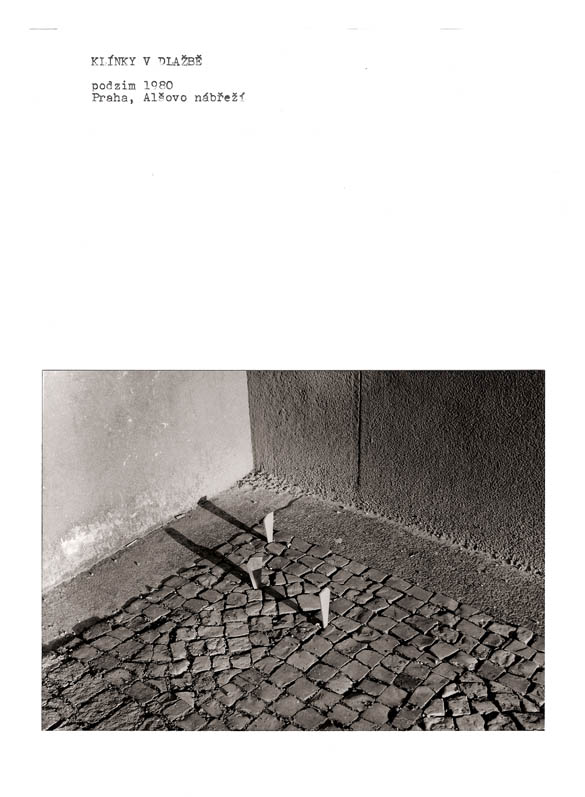
© » KADIST
Jiri Kovanda
Kovanda’s street interventions are always documented according to the same format as the actions: a piece of A4 paper, a typewritten text giving a precise location and date, and a photograph. Contrarily to the actions, he took the photographs himself. One of the rules he stuck to in his artistic practice was to always use material at his disposal, a real economy of means.

© » KADIST
Tadasu Takamine
The video work Japan Syndrome is a continuation of his lines of inquiry, taking post-Fukushima Japan as a case study. The work constructs a theatrical space in which the conflict-filled life sphere of post-Fukushima Japan, and perhaps beyond it, is reenacted in a minimal yet condensed fashion. To conceive this work, the artists has recorded real conversations he had with shop employees in Kyoto, Yamaguchi and Mito from 2011 to 2013, which have been then reenacted as performances in a studio, and recorded as the final form of this piece.

© » KADIST
Matthew Langan-Peck
Plane is an inflatable sculpture in the shape of an aeroplane made from numerous pieces of plastic bags assembled by an iron. The object is inflated by a fan at the structures base and deflates when it is deprived of its power source, causing the plane to sink. It is in this process that plane leans on its wings, evoking a crash, a defeat, or a failure.

© » KADIST
Martin Boyce
In the installation Our Love is like the Flowers, the Rain, the Sea and the Hours, Martin Boyce uses common elements from public gardens – trees, benches, trashbins– in a game which describes at once a social space and an abstract dream space. The trees, unique sources of light in the exhibition space, produce their own environment. These sculptures, as if extracted from a set, are enough to suggest an atmosphere, a landscape, or a movie.
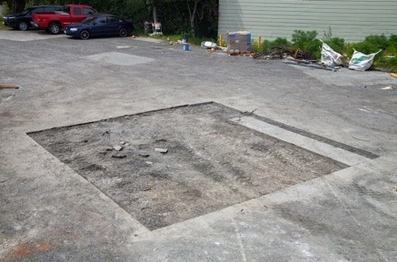
© » KADIST
Marcelo Cidade
450 Hayes Street (excavation site) by Marcelo Cidade is a large scale photograph documenting the artist’s excavation of a parking lot located at 450 Hayes Street in San Francisco, a former section of the city’s Central freeway and current condominium site. The cut shape mirrors the precise shape of the Kadist gallery floor, where the concrete was relocated as part of his residency exhibition entitled Somewhere, Elsewhere, Anywhere, Nowhere. Through this concrete graft, Cidade inextricably links the city with artwork.
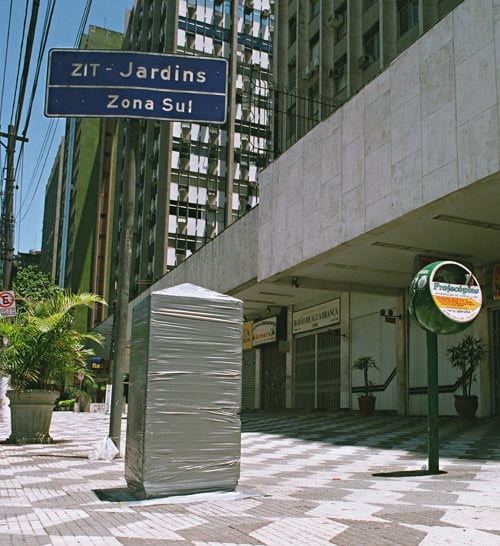
© » KADIST
Marcelo Cidade
This series of photographs reflects Marcelo Cidade’s incessant walks or drifting through the city and his chance encounters with a certain street poetry like the Surrealists or Situationists before him. He captures incongruities or everyday simplicity and highlights their suggestive power. The composition and framing of these interventions specially emphasizes the object of interest and the humor of the context.

© » KADIST
David Horvitz
The title of the work Eridanus refers to the constellation of the river of ancient Athens that meanders across in the night sky. The constellation is visible uniquely from the Southern Hemisphere. The artist evokes a story from the past, where with the installation of modern street lamps, has resulted in the residents of Paris being disturbed by the difficulty of seeing the stars in the sky as a result of light pollution.

© » KADIST
Ximena Garrido Lecca
Destilaciones ( Distillations , 2014) is an installation composed of a group of ceramic pots, presented on the floor and within a steel structure. Copper pipes run through the perforated ceramics, evoking the design of an oil purifier. The work is a direct reference to the history of the Peruvian coastal town of Lobitos.

© » KADIST
Julieta Aranda
The video Swimming in rivers of Glue is composed of various images of nature, exploring the themes of exploration of space and its colonization. The images show the diversity of forms of life on earth. These forms are associated with texts that relay a form of propaganda.

© » KADIST
Heman Chong
With a habit of reading eight to ten books at the same time, Chong paints his two-foot tall novel covers through referencing an extensive reading list (accessible on Facebook) he has kept since 2006. Entitled “Bibliography (1): The Lonely Ones,” the list outlines representations of solitude that has been imposed on individuals or communities. Chong divides these archetypes into three over-arching notions: the Hide-away, the Castaway and the Prisoner.

© » KADIST
Trisha Donnelly
Untitled is a black-and-white photograph of a wave just before it breaks as seen from the distance of an overlook. Donnelly’s interest in the waveform–visually, aurally, and perceptually–is made manifest in works across multiple media, including photography, drawing, video, sculpture, and performance.
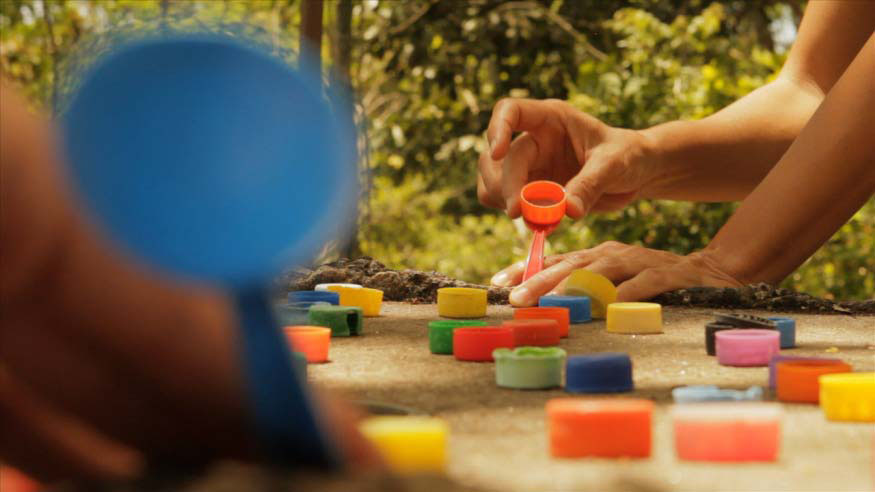
© » KADIST
Donna Conlon and Jonathan Harker
In Tapitapultas (2012), Donna Conlon and Jonathan Harker comment on mass consumerism and pollution by way of a game they invented. The artists used disposable spoons as catapults to shoot thousands of plastic bottle caps at a hole in a concrete platform. The platform was once part of a U. S. military installation in the Panama Canal Zone, and it is now an observation deck in a nature park.

© » KADIST
Lin Yilin
All his artworks utilize the use of body – the artist’s own body and that of others. The Result of 1000 Pieces typi?es an image of Lin: Lin is standing in an empty hole of a brick wall. By incorporating the brick wall for his work, Lin develops a speci?c strategy to question and negotiate with the relationship between people and the changing environments.

© » KADIST
Tacita Dean
The photographic quality of the film Baobab is not only the result of a highly sophisticated use of black and white and light, but also of the way in which each tree is characterized as an individual, creating in the end a series of portraits. The monumental and unnatural aspect of the baobabs turns them into strange and anthropomorphic personalities. Adding to the descriptive aspect of the film, the sound is a recording of the environment, of sounds made by animals, and participates in this peaceful contemplation.
Robert Zhao Renhui
Robert Zhao Renhui’s multimedia practice questions fact-based presentations of ecological conservation and reveals the manner in which documentary, journalistic, and scientific reports sensationalize nature in order to elicit viewer sympathy...
Mohamed Bourouissa
Mohamed Bourouissa became known in the 2000s with a series of photographs on young people in the suburbs of Paris...
Martin Boyce
- location: Hamilton, United Kingdom
- year born: 1967
- gender: male
- nationality: British
Lin Yilin
- location: Beijing & New York
- year born: 1964
- gender: male
- nationality: Chinese
- home town: Guangzhou, China
Engel Leonardo
Working with various mediums, from sculpture to installation, site-specific interventions, and readymades, Leonardo Engel addresses issues related to the climate, nature, traditional crafts, architecture, and popular culture of the Caribbean...
Yosuke Takeda
Yosuke Takeda started from experimenting with darkroom photography production and he shifted over to digital photography, aware that photographic film and paper were becoming obsolete...
Donna Conlon and Jonathan Harker
- location: Panama City, Panama
- year born: 1966
- nationality: American and Ecuadorian
John Gerrard
For more than two decades, John Gerrard has produced media work that has harnessed the emergent technologies of programming languages and gaming engines, and transmuted them into landscapes and portraits of ever increasing intricacy and autonomy...
Tacita Dean
- location: Berlin, Germany
- year born: 1965
- gender: female
- nationality: British
- home town: Canterbury, United Kingdom
Som Supaparinya
Humanity is not ontologically transcendent, artist Som Supaparinya’s work makes adamantly clear: actions energetically create impacts, experience dictated not only by our perceptions but equally the world that surrounds us, tethered inextricably...
David Horvitz
Although the practice plays a central role in the work of David Horvitz, his work is at the opposite of fine art objects...
Yuji Agematsu
Yuji Agematsu is an artist who works across various media, including sound, photography, and the arrangements of objects—not exactly sculpture...
Brook Andrew
Brook Andrew is a Wiradjuri and Ngunnawal Aboriginal Australian artist and scholar whose interdisciplinary practice examines hegemonic narratives relating to colonialism and modernism...
Otobong Nkanga
Visual artist and performer, Otobong Nkanga’s (b...
Prabhakar Pachpute
Prabhakar Pachpute calls attention to issues concerning land politics, industry, and labor through a multimedia practice that includes drawing, painting, sculpture, animation, and murals...
Trisha Donnelly
- location: New York, New York
- year born: 1974
- gender: male
- nationality: American
- home town: San Francisco, California
Benvenuto Chavajay Gonzalez
Benvenuto Chavajay’s body of work includes sculpture, interventions into objects, installation, performance, and painting...
Jiri Kovanda
- location: Praha, Ceská Republika
- year born: 1953
- gender: male
- nationality: Czech
Tadasu Takamine
Tadasu Takamine is one of the most controversial, thought provoking, and irreverent media, video and installation artist working in Japan...
Chris Wiley
- location: New York, New York
- year born: 1981
- gender: male
- nationality: British
Leticia Ramos
Trained as a filmmaker, Leticia Ramos has cultivated a specific interest in the procedures and evolution of photography and film techniques since the beginning of her career in the early 2000s...
Xiaoyun Chen
- location: Hangzhou, China
- year born: 1971
- gender: male
- nationality: Chinese
- home town: Hubei Province, China
Ximena Garrido Lecca
- location: London, United Kingdom
- year born: 1980
- gender: female
- nationality: Peruvian
- home town: Lima, Peru
Connie Zheng
Connie Zheng is an artist, writer, filmmaker, and field recordist...
Khvay Samnang
Khvay Samnang’s work critically examines the interlocking nature of ritual and politics, the humanitarian and ecological impacts of globalization, colonialism and migration, and the cultural-material histories of exchange that have shaped the Southeast Asia region...
Heman Chong
- year born: 1977
- gender: male
- nationality: Singaporean
- home town: Muar, Malaysia
Andrey Shental
Andrey Shental is an independent artist, theorist, cultural critic, and curator based in Moscow...
Julieta Aranda
- location: Mexico City, Mexico
- year born: 1975
- gender: female
- nationality: Mexican
- home town: Mexico City, Mexico
-
1980-1989
Jiri Kovanda
1980Kovanda’s street interventions are always documented according to the same format as the actions: a piece of A4 paper, a typewritten text giving a precise location and date, and a photograph...
-
-
2000-2009
Tacita Dean
2001The photographic quality of the film Baobab is not only the result of a highly sophisticated use of black and white and light, but also of the way in which each tree is characterized as an individual, creating in the end a series of portraits...
Martin Boyce
2003In the installation Our Love is like the Flowers, the Rain, the Sea and the Hours, Martin Boyce uses common elements from public gardens – trees, benches, trashbins– in a game which describes at once a social space and an abstract dream space...
Marcelo Cidade
2006This series of photographs reflects Marcelo Cidade’s incessant walks or drifting through the city and his chance encounters with a certain street poetry like the Surrealists or Situationists before him...
Trisha Donnelly
2007Untitled is a black-and-white photograph of a wave just before it breaks as seen from the distance of an overlook...
Otobong Nkanga
2008Born in 1974, Kano, Nigeria, Otobong Nkanga lives and works in Antwerp, Belgium...
Heman Chong
2009With a habit of reading eight to ten books at the same time, Chong paints his two-foot tall novel covers through referencing an extensive reading list (accessible on Facebook) he has kept since 2006...
-
2010-2019
Ana Roldán
2012Ana Roldán’s Primeval forms series looks up close at the fecund shapes of plants often found in the artist’s native Mexico...
Donna Conlon and Jonathan Harker
2012In Tapitapultas (2012), Donna Conlon and Jonathan Harker comment on mass consumerism and pollution by way of a game they invented...
Robert Zhao Renhui
2012Changi, Singapore, possibly 1970s is from the series “As We Walked on Water” (2010-2012), which looks into Singapore’s history around the phenomenon of land reclamation...
Tadasu Takamine
2012The video work Japan Syndrome is a continuation of his lines of inquiry, taking post-Fukushima Japan as a case study...
Chris Wiley
2012Architectural details become abstracted renderings in Chris Wiley’s inkjet prints 11 and 20 (both 2012)...
Benvenuto Chavajay Gonzalez
2013Jardín (2013) refers to environmental destruction, specifically the preponderance of disposable plastics, as well as Medellín’s long history of dangerous conflict; it was once considered the most violent city in the world because of the drug trafficking there...
Carlos Fernández
2014Part of the exhibition PIÑA MATRIZ (2014) at Despacio Art, this untitled work by Carlos Fernández is a wood panel (formerly a section of a wooden table top) that bears the residue of insects interacting with fermented pineapple...
Marcelo Cidade
2014450 Hayes Street (excavation site) by Marcelo Cidade is a large scale photograph documenting the artist’s excavation of a parking lot located at 450 Hayes Street in San Francisco, a former section of the city’s Central freeway and current condominium site...
Ximena Garrido Lecca
2014Destilaciones ( Distillations , 2014) is an installation composed of a group of ceramic pots, presented on the floor and within a steel structure...
Som Supaparinya
2014When Need Moves the Earth is a three-channel video that combines elements of documentary footage, archival material and abstract aerial shots to encompass a painterly yet forthright exploration of a coal mine and a water dam in Thailand...
Robert Zhao Renhui
2014Created during Zhao Renhui’s residency at Kadist SF in 2014, Zhao Renhui began observing and cataloguing insects inspired by the scientific impulse towards exhaustive taxonomy of Sacramento-based Dr...
Prabhakar Pachpute
2014“Dark Clouds Of The Future” is a cinematographic video animation of the abandoned gold mine in Brazil, Serra Pelada (“Naked Mountain”)...
Khvay Samnang
2014The video Rubber Man continues exploring issues related to land use, also noticeable in his Untitled series (2011)...
Yosuke Takeda
2014Yosuke Takeda gives the viewer brightly colored views, each of which he has searched out and patiently waited for...
Xiaoyun Chen
2014The central point of Vanishing Point is the most direct physiological reaction of the body to the environment...
Yuji Agematsu
2015Each day, Yuji Agematsu smokes a pack of cigarettes and wanders the streets of New York City looking for trash...
John Gerrard
2016Flag (Thames) 2016 depicts a small section of the Thames River—one that is adjacent to the Palace of Westminster in London—as an algorithmic representation on an LED panel...
Matthew Langan-Peck
2016Plane is an inflatable sculpture in the shape of an aeroplane made from numerous pieces of plastic bags assembled by an iron...
Julieta Aranda
2016The video Swimming in rivers of Glue is composed of various images of nature, exploring the themes of exploration of space and its colonization...
David Horvitz
2017The title of the work Eridanus refers to the constellation of the river of ancient Athens that meanders across in the night sky...
Mohamed Bourouissa
Drawing & Print
2017(Drawing & Print) In his photographic series Périphérique (2005–2008), Mohamed Bourouissa used the composition of classical paintings to stage the portrait of friends and young people in the banlieue s (suburbs)...
Connie Zheng
2019The Lonely Age by Connie Zheng is the first chapter in a trilogy of short experimental films about the complex temporalities of navigating ongoing environmental crises, as seen through the lens of seeds real and imagined...
-
2020-2029
Brook Andrew
2020This year: missing witness by Brook Andrew consists of a multi-layered collage of photographs...
Noémie Goudal
2021Noémie Goudal’s short film, Below the Deep South , is based on the work of palaeoclimatologist James Bendle who, while drilling in Antarctica, discovered coal beneath the ice...
Leticia Ramos
2021Leticia Ramos’s film DROPSPIKE is the second of a five-part film project entitled STORIES OF THE END OF THE WORLD ...
Enar de Dios Rodríguez
2022Ecotone by Enar de Dios Rodríguez is a video work presented in six chapters, each beginning and ending with a one-sided telephone dialog with an informal, friendly and conversational tone, that leads quickly into complex philosophical subjects...
Miguel and Natalia Fernández de Castro and Mendoza
2022The Absolute Restoration of All Things is a collaboration by artist Miguel Fernández de Castro and anthropologist Natalia Mendoza...
Ana Vaz
2022Ana Vaz describes her film É Noite na América (It is Night in America) as an eco-terror tale, freely inspired by A cosmopolitics of animals by Brazilian philosopher Juliana Fausto; in which she investigates the political life of non-human beings and questions the modern idea of the exceptionality of the human species...



